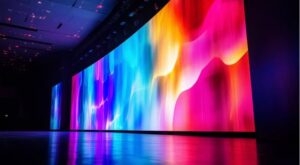Vertical Market - Museums
Museums have long been guardians of history, culture, science, and art—but in the digital age, they are evolving into dynamic, interactive spaces that captivate, educate, and inspire audiences like never before. At the center of this transformation is LED display technology, which offers museums powerful new ways to present content, tell stories, and engage visitors of all ages. From immersive exhibitions and interactive timelines to digital signage and virtual tours, LED displays are reimagining what it means to experience a museum.
One of the most impactful uses of LED technology in museums is in the creation of immersive, multimedia exhibits. High-resolution LED video walls can transport visitors into different times, places, and worlds by displaying vibrant visuals, animated sequences, and cinematic storytelling across large-scale surfaces. Whether recreating a historic battlefield, visualizing the cosmos, or presenting an artist’s process in motion, LED walls allow museums to go beyond static displays and bring content to life in dynamic and emotionally engaging ways.
In art and cultural museums, LED displays offer a platform for showcasing digital art and new media installations, including video art, motion graphics, and NFTs. These formats require high-resolution, color-accurate canvases to be properly appreciated, and fine pixel pitch LED panels deliver just that—providing vibrant, seamless visuals without distracting bezels. In addition, curators can easily rotate or update content, creating a flexible environment for temporary exhibits or seasonal themes.
Interactivity is another key advantage of LED technology in museums. When paired with motion sensors, touch interfaces, or augmented reality systems, LED displays allow visitors to interact directly with exhibits—exploring artifacts in 3D, navigating digital timelines, or triggering animations with gestures. These interactive elements not only engage younger audiences but also cater to diverse learning styles, making museum content more accessible and memorable for all.
Beyond exhibition spaces, digital signage powered by LED displays plays an important role in museum operations. Strategically placed LED screens in lobbies, hallways, and entrances can display wayfinding information, exhibit details, ticketing updates, or special announcements. Because LED displays are bright, durable, and easily updated in real-time, they offer museums a highly effective communication tool that enhances the visitor experience from arrival to departure.
For museum theaters and auditoriums, LED video walls provide the perfect solution for presentations, educational programming, guest lectures, and screenings. With high brightness, wide viewing angles, and exceptional clarity, LED displays ensure that all audience members enjoy a high-quality visual experience—regardless of room size or lighting conditions.
Importantly, LED display systems are also sustainable and future-ready. Their energy-efficient performance, long lifespan, and modular design make them a smart investment for institutions seeking to modernize their infrastructure while maintaining operational efficiency.
In essence, LED display technology empowers museums to tell richer, more immersive stories—blending tradition with innovation to meet the expectations of today’s tech-savvy visitors. As museums continue to evolve, LED displays will play a central role in transforming these cultural spaces into engaging, inclusive, and interactive environments for learning and discovery.






